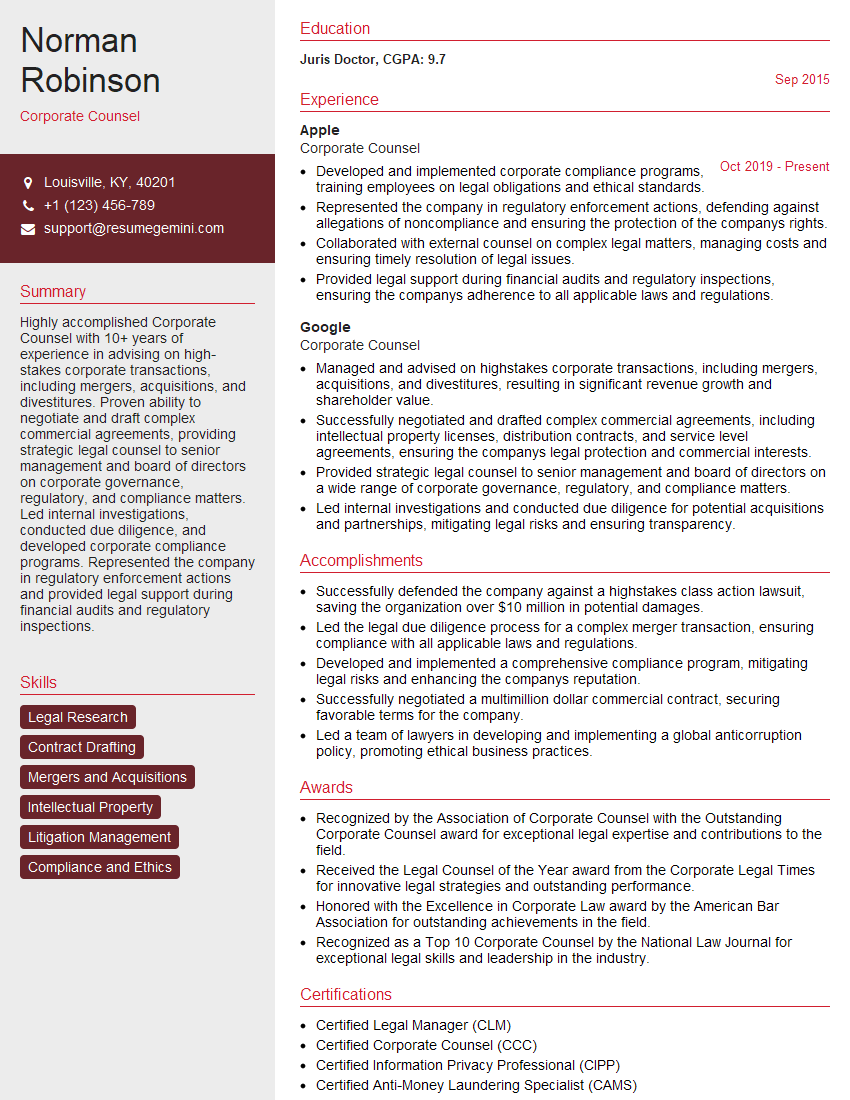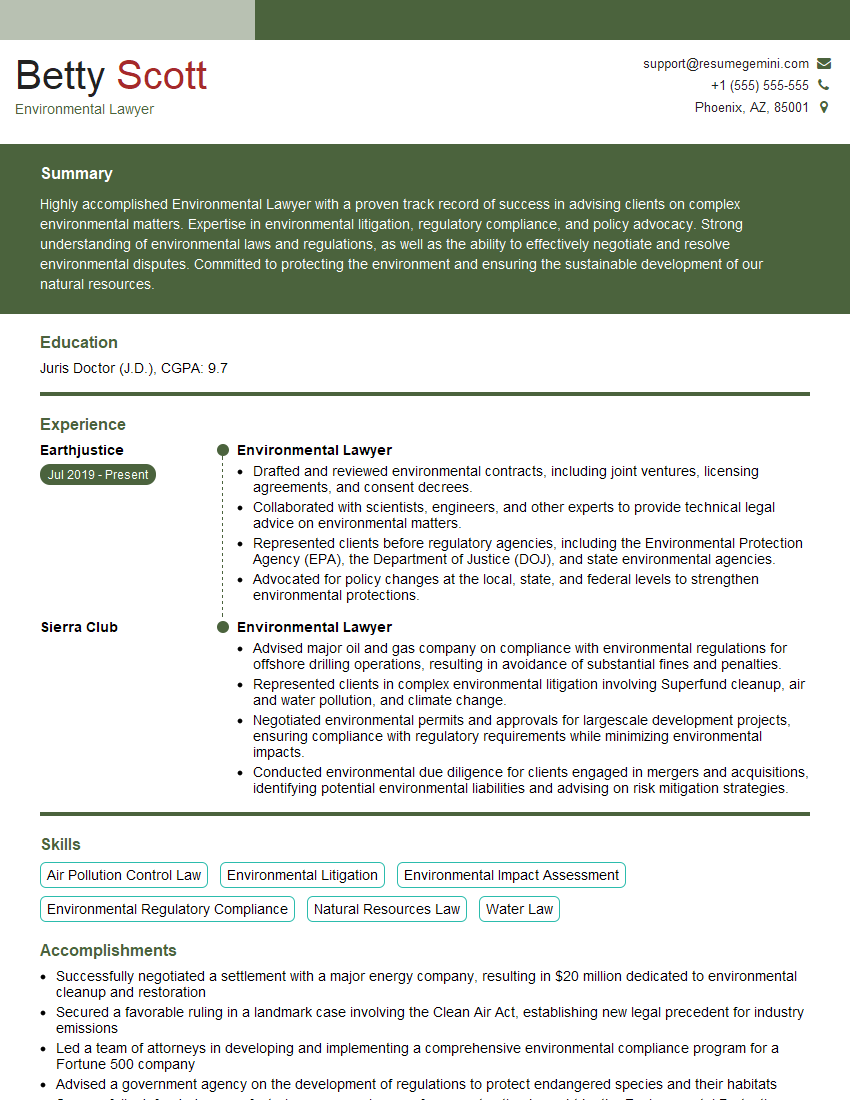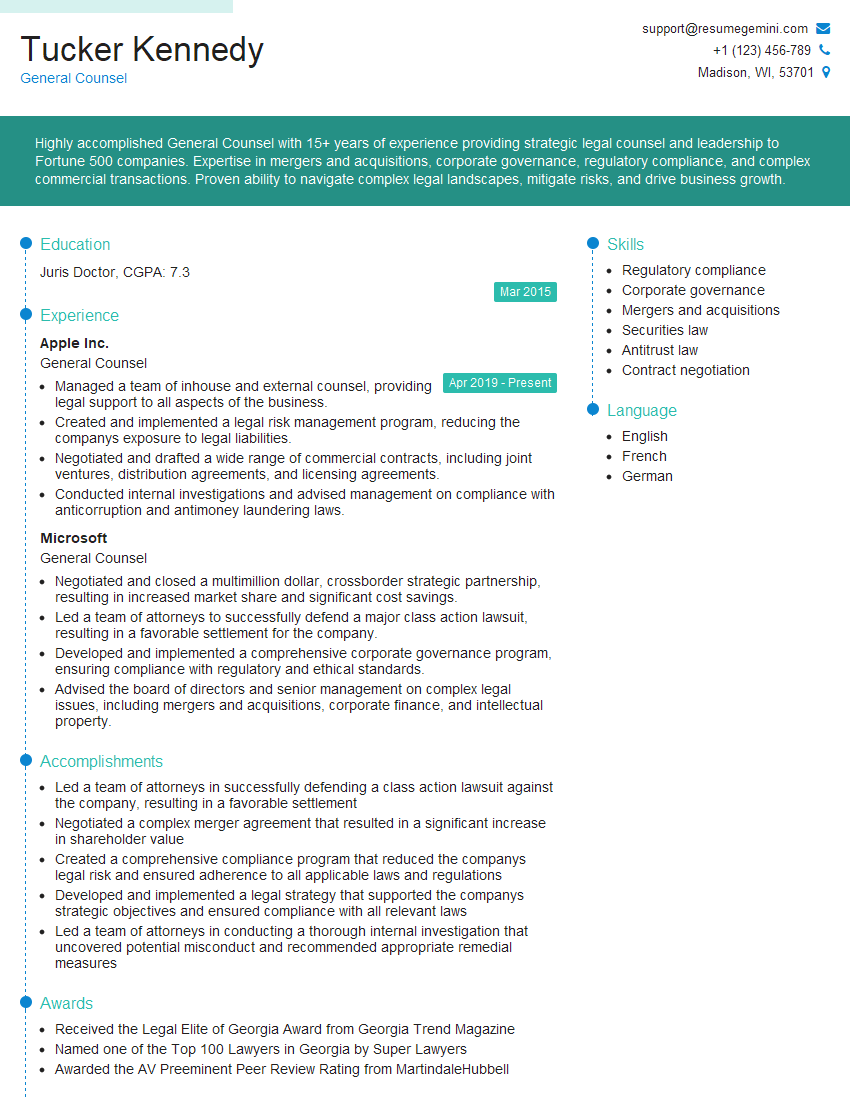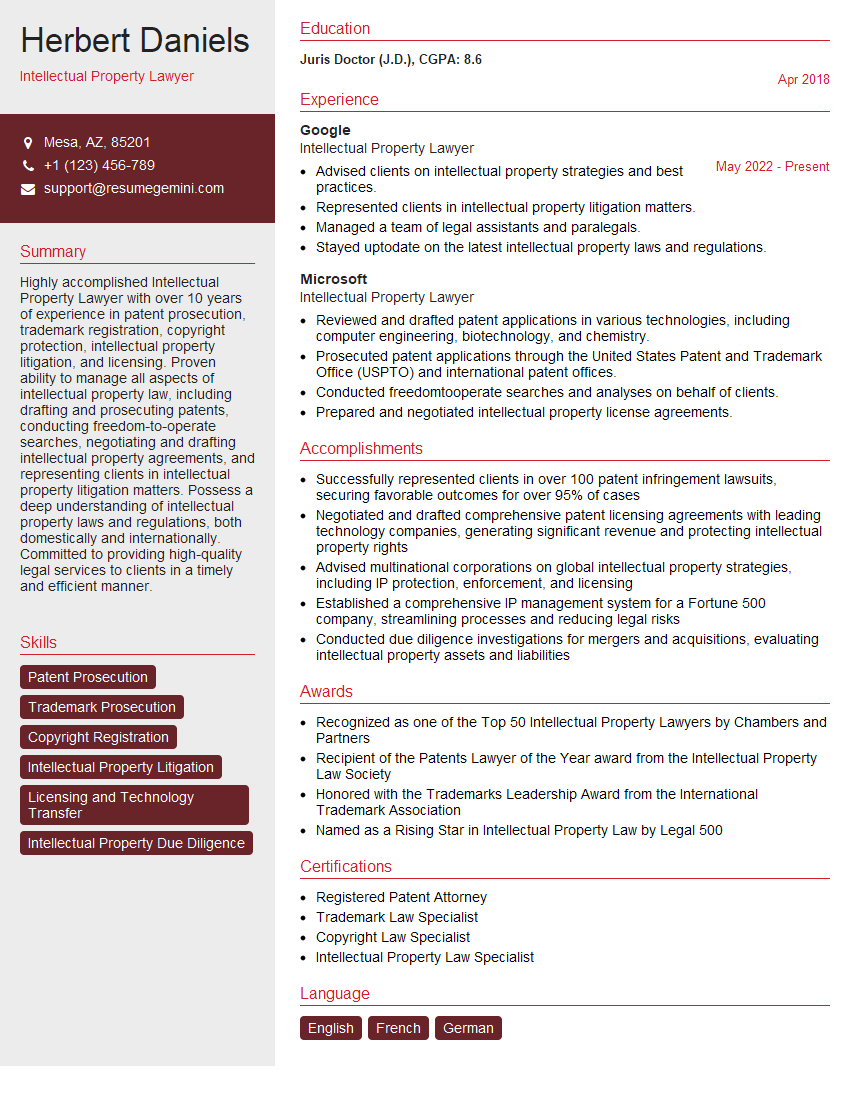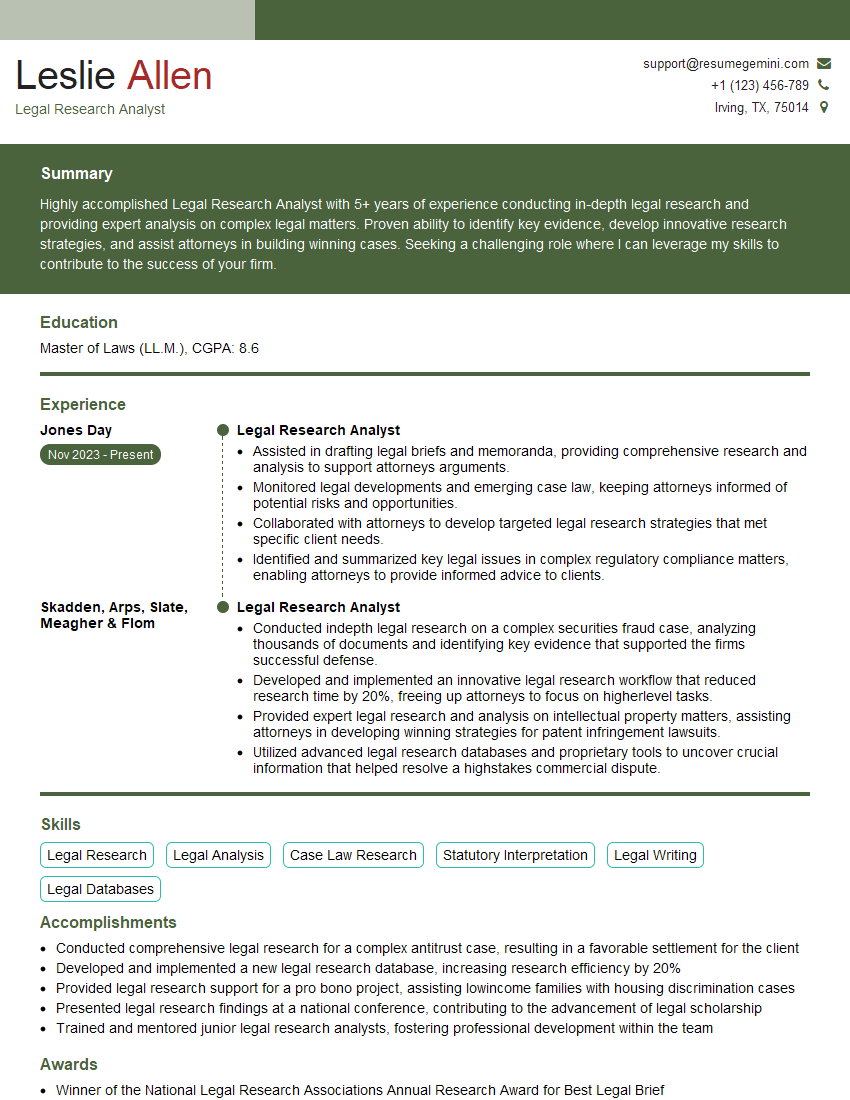Interviews are opportunities to demonstrate your expertise, and this guide is here to help you shine. Explore the essential Understanding of Legal and Ethical Considerations interview questions that employers frequently ask, paired with strategies for crafting responses that set you apart from the competition.
Questions Asked in Understanding of Legal and Ethical Considerations Interview
Q 1. Explain the concept of ‘due diligence’ in a legal and ethical context.
Due diligence, in a legal and ethical context, is the process of investigating and verifying all aspects of a transaction, decision, or action to ensure it’s legally sound and ethically responsible. Think of it as a thorough background check before making a significant commitment. It aims to minimize risks and potential liabilities by uncovering any hidden problems or potential violations.
- Legal Due Diligence: This involves examining legal documents, contracts, permits, licenses, and regulatory compliance to ensure the action aligns with relevant laws and regulations. For example, a company acquiring another company would conduct legal due diligence to ensure the target company is free of outstanding lawsuits or environmental violations.
- Ethical Due Diligence: This focuses on identifying potential ethical conflicts or risks, such as potential harm to stakeholders, environmental impact, or breaches of trust. For example, a company developing a new technology would conduct ethical due diligence to ensure the technology’s responsible use and address potential biases or societal impacts.
Both legal and ethical due diligence are crucial for informed decision-making, risk mitigation, and maintaining a strong reputation.
Q 2. Describe a situation where you had to balance competing legal and ethical obligations.
In a previous role, I was involved in a project where we needed to release certain information to the public in the interest of transparency, but doing so could potentially have violated the confidentiality clause of a non-disclosure agreement (NDA). Balancing the ethical imperative of transparency against the legal obligation of confidentiality required careful consideration.
We addressed this by consulting with legal counsel to explore options for redacting sensitive information while still providing the public with crucial information. We also explored alternative methods of communication, ensuring that the public’s right to know was satisfied without jeopardizing legal commitments. Ultimately, we developed a strategy that fulfilled both our ethical and legal obligations.
Q 3. How would you handle a conflict of interest in the workplace?
Handling conflicts of interest requires immediate and transparent action. The first step is to recognize the conflict – this means honestly assessing whether my personal interests, or those of a close relation, could potentially influence my professional judgment or actions.
- Disclosure: If a conflict arises, I would immediately disclose it to my supervisor or the relevant ethics committee. Open and honest communication is key.
- Recusal: I would recuse myself from any decisions or actions where my personal interests could be perceived as influencing my professional judgment. This avoids even the appearance of impropriety.
- Mitigation Strategies: If recusal isn’t possible, I would work with my supervisor to develop mitigation strategies to minimize the potential impact of the conflict. This might involve implementing additional oversight or seeking independent advice.
Following established protocols and seeking guidance are crucial in maintaining ethical conduct and preventing any potential violations.
Q 4. What is your understanding of data privacy regulations (e.g., GDPR, CCPA)?
Data privacy regulations like the General Data Protection Regulation (GDPR) in Europe and the California Consumer Privacy Act (CCPA) in California are designed to protect individuals’ personal data. They establish requirements for how organizations collect, use, store, and share personal information.
- GDPR: Applies to any organization processing personal data of EU residents, regardless of the organization’s location. It emphasizes consent, data minimization, and the right to be forgotten.
- CCPA: Grants California residents specific rights regarding their personal data, including the right to know, delete, and opt-out of the sale of their data.
These regulations share the common goal of empowering individuals with control over their personal information, but they have different scopes and specific requirements. Understanding these nuances is crucial for ensuring compliance.
Q 5. Explain the difference between legal compliance and ethical conduct.
While legal compliance focuses on adherence to the letter of the law, ethical conduct considers the spirit of the law and broader moral principles. Legal compliance is the minimum standard, while ethical conduct goes beyond that to encompass fairness, responsibility, and integrity.
For example, a company might legally comply with minimum wage laws but ethically choose to pay its employees a higher wage reflecting a commitment to fair compensation. Another example might be legally permissible advertising but ethically questionable given it could mislead customers.
Q 6. How do you stay up-to-date on changes in relevant laws and regulations?
Staying current requires a multi-pronged approach:
- Professional Development: I regularly attend conferences, webinars, and workshops related to legal and ethical issues in my field.
- Legal News and Publications: I subscribe to reputable legal publications, newsletters, and online resources that provide updates on relevant laws and regulations.
- Networking: I maintain professional relationships with legal experts and colleagues to share knowledge and insights.
- Continuing Education: I participate in continuing legal education (CLE) courses to maintain my knowledge and earn necessary credits (where applicable).
This ongoing process ensures my understanding of the legal and ethical landscape remains current and comprehensive.
Q 7. Describe your experience with conducting legal research.
My legal research experience involves utilizing various resources, including:
- Legal Databases (e.g., Westlaw, LexisNexis): I’m proficient in using these databases to locate relevant case law, statutes, regulations, and legal scholarship.
- Online Legal Research Tools: I utilize online resources and government websites to access legal documents and official guidance.
- Traditional Legal Research Methods: I’m familiar with utilizing law libraries and conducting manual research when necessary.
My research process is systematic and involves clearly defining the research question, identifying relevant keywords, and critically evaluating the sources. I always cite my sources appropriately.
Q 8. How would you respond to allegations of unethical behavior within your team?
Allegations of unethical behavior are treated with utmost seriousness. My response would involve a thorough and impartial investigation, ensuring due process for all involved. This starts with carefully documenting the allegations, including who made them, when, and the specific details. I would then initiate an internal investigation, potentially involving an independent third party if the situation warrants it. This investigation would involve interviewing witnesses, reviewing relevant documents, and gathering evidence. Based on the findings, appropriate disciplinary action, ranging from a verbal warning to termination, would be taken. Transparency is key throughout this process; those involved would be kept informed of the investigation’s progress and its outcome. For instance, if a team member was accused of data misuse, I would gather evidence, interview the accused and others, and compare the actions to company policy. The outcome may involve retraining, disciplinary action, or referral to legal authorities depending on the severity.
Q 9. Explain the concept of whistleblowing and its legal implications.
Whistleblowing is the act of reporting illegal or unethical activities within an organization to an external authority, such as a regulatory agency or the media. It’s a crucial mechanism for accountability and transparency, often protected by law. Laws like the Sarbanes-Oxley Act in the US, and similar legislation globally, offer protection to whistleblowers against retaliation. However, legal implications depend on the jurisdiction and specifics of the situation. For example, false accusations can lead to legal repercussions for the whistleblower. To be legally protected, whistleblowers usually need to demonstrate that they acted in good faith, had reasonable grounds to believe the activity was illegal or unethical, and followed proper internal reporting procedures before going external. A successful whistleblower case often hinges on the strength of the evidence presented.
Q 10. How would you handle a situation where a colleague is violating company policy?
Handling a colleague violating company policy requires a measured approach. I would first privately address the issue with the colleague, explaining the specific policy violation and its potential consequences. This conversation would focus on understanding the reason for the violation and helping them correct their behavior. If the violation is minor and unintentional, a verbal warning or additional training might suffice. However, for more serious or repeated offenses, written warnings, disciplinary action, and even termination might be necessary. Documentation of the entire process, including all conversations and actions taken, is crucial. For example, if a colleague consistently misses deadlines, I would address the issue privately, offering support and resources to help them manage their time. If the problem persists, more formal measures would follow, ensuring fairness and consistency.
Q 11. Describe your understanding of intellectual property rights.
Intellectual property (IP) rights are the legal rights granted to the creators of original works, including inventions, artistic works, and literary and musical compositions. These rights protect the creators’ ownership and control over their creations. Key types of IP rights include patents (for inventions), copyrights (for creative works), and trademarks (for brands and logos). Understanding IP rights is crucial in any business setting to protect innovations, creative content, and brand identity. Failure to respect IP rights can lead to infringement lawsuits with serious financial and reputational consequences. For instance, using a copyrighted image without permission is copyright infringement and may lead to legal action. Similarly, using a registered trademark without permission constitutes trademark infringement.
Q 12. What is your experience with contract negotiation and review?
My experience with contract negotiation and review is extensive. I’m proficient in identifying key terms, analyzing potential risks and liabilities, and negotiating favorable outcomes for my organization. I approach contract review systematically, focusing on clauses related to payment terms, confidentiality, intellectual property ownership, termination rights, and dispute resolution mechanisms. I leverage my legal knowledge to ensure that contracts align with relevant laws and regulations. I’ve successfully negotiated numerous contracts, achieving mutually beneficial agreements while mitigating potential risks. For example, I recently negotiated a contract where I successfully secured a more favorable payment schedule and clarified ambiguities in the intellectual property ownership clause.
Q 13. Explain the importance of corporate governance.
Corporate governance is the system of rules, practices, and processes by which a company is directed and controlled. It ensures accountability to shareholders and other stakeholders. Effective corporate governance promotes transparency, ethical behavior, and responsible decision-making. It involves establishing clear roles and responsibilities, implementing robust internal controls, and fostering a culture of compliance. Good corporate governance reduces risks, builds trust, and enhances a company’s reputation and long-term value. For example, a company with strong corporate governance will have a clearly defined board of directors with diverse skills and experience, regular audits, and transparent financial reporting. Lack of good corporate governance may lead to scandals, legal issues, and loss of investor confidence.
Q 14. How do you ensure compliance with anti-bribery and anti-corruption laws?
Ensuring compliance with anti-bribery and anti-corruption laws requires a multi-faceted approach. This includes establishing a robust compliance program with clearly defined policies and procedures, providing regular training to employees on these laws and regulations, implementing effective internal controls to prevent bribery and corruption, and conducting regular internal audits to identify and address potential vulnerabilities. We must also establish clear reporting mechanisms for employees to raise concerns without fear of retaliation. Furthermore, due diligence should be conducted on all business partners and suppliers to mitigate risks. For example, we would implement a system for recording all gifts and entertainment received from business partners, ensuring transparency and adherence to our anti-bribery policy. Non-compliance with anti-bribery laws can result in heavy fines and legal repercussions for individuals and the company.
Q 15. Describe your experience with internal investigations.
Internal investigations are crucial for maintaining ethical standards and legal compliance within an organization. My experience encompasses leading and participating in investigations into allegations of misconduct, including financial irregularities, violations of company policy, and breaches of law. This involves a multi-faceted approach.
- Initial Assessment: Carefully reviewing the initial complaint or allegation, identifying key stakeholders and potential witnesses, and determining the scope of the investigation.
- Evidence Gathering: Employing various methods to collect evidence, such as interviews, document reviews, data analysis, and forensic accounting techniques. This includes ensuring chain of custody and preserving the integrity of evidence.
- Interviewing: Conducting thorough and legally sound interviews with relevant individuals, ensuring their rights are respected and using techniques to elicit truthful and accurate information.
- Report Writing: Preparing detailed, objective, and factual reports summarizing findings, conclusions, and recommendations for corrective action. These reports need to be legally sound and defensible.
- Recommendation Implementation: Advising on appropriate disciplinary actions, policy changes, or remedial measures based on the investigation’s findings.
For example, I once led an investigation into suspected accounting fraud which resulted in the identification of a fraudulent scheme, leading to the recovery of significant funds and the implementation of enhanced internal controls.
Career Expert Tips:
- Ace those interviews! Prepare effectively by reviewing the Top 50 Most Common Interview Questions on ResumeGemini.
- Navigate your job search with confidence! Explore a wide range of Career Tips on ResumeGemini. Learn about common challenges and recommendations to overcome them.
- Craft the perfect resume! Master the Art of Resume Writing with ResumeGemini’s guide. Showcase your unique qualifications and achievements effectively.
- Don’t miss out on holiday savings! Build your dream resume with ResumeGemini’s ATS optimized templates.
Q 16. How would you assess and mitigate legal and ethical risks?
Assessing and mitigating legal and ethical risks is an ongoing process requiring proactive measures. My approach involves:
- Risk Identification: Regularly identifying potential risks through various methods including risk assessments, legal updates, industry best practices review, and internal audits. This includes considering both legal and reputational risks.
- Risk Analysis: Evaluating the likelihood and potential impact of each identified risk. This involves considering the potential financial, legal, and reputational consequences.
- Risk Mitigation: Developing and implementing strategies to reduce or eliminate identified risks. Strategies might include creating and enforcing clear policies, providing training programs, establishing robust internal controls, and implementing technology solutions like data encryption.
- Monitoring and Review: Continuously monitoring the effectiveness of implemented mitigation strategies and adapting them as needed. This is a cyclical process.
For instance, if a company is expanding into a new market with different data protection laws, we’d conduct a thorough risk assessment, focusing on data privacy and security. Mitigation strategies might involve adapting to the new regulations, implementing additional security measures, and providing staff with relevant training.
Q 17. What is your understanding of corporate social responsibility?
Corporate Social Responsibility (CSR) is the commitment of a company to act ethically and contribute positively to society. It’s more than just philanthropy; it involves integrating social and environmental concerns into a company’s business operations and interactions with stakeholders.
A robust CSR program encompasses:
- Environmental Sustainability: Reducing environmental impact through sustainable practices, waste reduction, and energy efficiency.
- Ethical Labor Practices: Fair wages, safe working conditions, and respect for human rights throughout the supply chain.
- Community Engagement: Supporting local communities through charitable donations, volunteer work, and community development initiatives.
- Transparency and Accountability: Openly communicating a company’s social and environmental performance and being accountable for its actions.
A company demonstrating strong CSR builds trust with consumers, attracts and retains talent, and enhances its reputation. Ignoring CSR can lead to negative publicity, boycotts, and legal challenges.
Q 18. How would you handle a situation involving a data breach?
Handling a data breach requires a swift and decisive response that prioritizes legal compliance, data protection, and communication. My approach follows a structured process:
- Containment: Immediately containing the breach to limit further damage and prevent data exfiltration. This often involves isolating affected systems.
- Assessment: Determining the scope of the breach, identifying affected data, and assessing the potential impact on individuals and the organization.
- Notification: Notifying affected individuals, regulatory authorities (as required), and relevant stakeholders according to legal and regulatory requirements. This includes providing clear and concise information about the breach and steps taken to mitigate the risk.
- Remediation: Implementing measures to prevent future breaches, such as improving security protocols, vulnerability patching, and employee training.
- Documentation: Thoroughly documenting all aspects of the breach response, including steps taken, findings, and remediation efforts. This is critical for legal and regulatory compliance.
It’s crucial to prioritize transparency and act quickly. Delaying notification or failing to follow regulatory guidelines can lead to significant legal penalties and reputational damage.
Q 19. Explain your understanding of employment law.
Employment law governs the relationship between employers and employees. It encompasses a wide range of areas including:
- Hiring and Firing: Laws related to recruitment, selection, termination, and wrongful dismissal. This often involves considerations of discrimination, fair process and due diligence.
- Compensation and Benefits: Laws regarding minimum wage, overtime pay, benefits (e.g., health insurance, retirement plans), and equal pay.
- Working Conditions: Laws related to workplace safety, harassment and discrimination, and employee privacy. This includes the legal obligation to provide a safe and respectful work environment.
- Employee Rights: Laws protecting employees from discrimination based on factors such as race, religion, gender, age, and disability.
Understanding employment law is vital for businesses to ensure compliance, avoid costly litigation, and maintain a positive employee relations. Ignoring employment laws can result in significant fines and damage to company reputation.
Q 20. Describe your experience with regulatory reporting and compliance.
Regulatory reporting and compliance are essential for businesses to operate legally and ethically. My experience involves:
- Identifying Applicable Regulations: Identifying all relevant laws, rules, and regulations that apply to a business, considering factors like industry, location, and activities.
- Establishing Compliance Programs: Designing and implementing internal controls and procedures to ensure ongoing compliance with all applicable regulations. This includes developing policies, training employees, and conducting regular audits.
- Data Management and Reporting: Accurately collecting, managing, and reporting data as required by various regulators. This requires meticulous record-keeping and understanding specific reporting requirements.
- Responding to Regulatory Inquiries: Responding to inquiries and audits from regulatory agencies in a timely and professional manner. This includes assembling the appropriate documentation and engaging with the authorities in a transparent manner.
For example, I’ve assisted companies in navigating the complexities of financial regulations, data privacy laws, and environmental protection rules, ensuring they meet all reporting obligations and avoid penalties.
Q 21. How would you handle a situation where a client is asking you to act unethically?
If a client requests unethical behavior, my response would be firm and unwavering. I would explain why the request is ethically problematic and potentially illegal. I would refuse to comply with unethical instructions, and if the situation persists, I would consider terminating the client relationship.
My ethical responsibilities outweigh any potential financial gain. I would document the client’s request, my refusal, and any subsequent actions. This documentation would protect me against potential liability and demonstrate adherence to my professional ethics. If the unethical request is severe enough, I may report it to relevant authorities.
Maintaining professional integrity is paramount. Compromising ethical standards risks significant professional and personal consequences.
Q 22. What is your understanding of environmental regulations?
Environmental regulations are laws and policies designed to protect the environment and human health from the harmful effects of pollution and environmental degradation. These regulations cover a wide range of activities, from industrial emissions and waste disposal to the protection of endangered species and natural resources. They’re implemented at various levels – local, national, and international – and often involve complex interplay between government agencies, businesses, and the public.
- Examples: The Clean Air Act (US), the Clean Water Act (US), the Endangered Species Act (US), and various international treaties like the Kyoto Protocol and the Paris Agreement all fall under this umbrella. Specific regulations might dictate allowable levels of pollutants in water discharge, standards for vehicle emissions, or restrictions on deforestation in protected areas.
- Practical Application: Businesses must understand and comply with relevant environmental regulations to avoid fines, legal action, and reputational damage. This includes conducting environmental impact assessments, implementing pollution control measures, and obtaining necessary permits and licenses. Failure to do so can lead to serious consequences, including facility closures and criminal charges.
Q 23. Explain the concept of informed consent.
Informed consent is a fundamental ethical and legal principle requiring that individuals have sufficient information to make a voluntary and autonomous decision regarding their participation in a process, typically in healthcare, research, or other situations involving personal risk or impact. It goes beyond mere agreement; it necessitates a true understanding of the implications.
- Key Elements: Capacity (ability to understand), disclosure (providing all relevant information, including risks and benefits), comprehension (understanding of the information), voluntariness (absence of coercion), and authorization (giving consent).
- Example: Before undergoing surgery, a patient must be fully informed about the procedure, its potential benefits, risks (including complications and side effects), alternative treatments, and the possibility of refusing treatment. The explanation must be clear, jargon-free, and tailored to the patient’s understanding. Documentation of informed consent is crucial.
- Practical Application: In research, informed consent forms meticulously detail the study’s purpose, procedures, potential risks and benefits, participant rights, and data confidentiality. Failing to obtain valid informed consent can have serious legal and ethical ramifications, including lawsuits and damage to reputation.
Q 24. Describe your experience with risk assessment and management.
Risk assessment and management is a systematic process of identifying, analyzing, and mitigating potential hazards and risks. It involves understanding the likelihood of an event occurring and the potential consequences if it does. My experience involves employing various frameworks and methodologies to comprehensively evaluate risks and develop strategies to control or minimize them.
- Process: The process generally involves identifying potential risks, analyzing their likelihood and impact, evaluating existing controls, developing mitigation strategies, implementing those strategies, monitoring their effectiveness, and regularly reviewing the entire process.
- Methodologies: I’ve utilized frameworks such as FMEA (Failure Mode and Effects Analysis), HAZOP (Hazard and Operability Study), and risk matrices to conduct thorough risk assessments. These methodologies provide structured approaches to systematically identify and analyze risks.
- Example: In a workplace setting, a risk assessment might involve identifying hazards such as slips, trips, and falls, evaluating their likelihood and potential severity (e.g., minor injury versus death), implementing control measures such as improved lighting and non-slip flooring, and monitoring the effectiveness of these measures.
Q 25. How do you ensure data security and confidentiality?
Data security and confidentiality are paramount. My approach involves implementing a multi-layered strategy focused on protecting sensitive data from unauthorized access, use, disclosure, disruption, modification, or destruction.
- Measures: This includes implementing strong access controls (passwords, multi-factor authentication), data encryption (both in transit and at rest), regular security audits and vulnerability assessments, employee training on security best practices, incident response planning, and adherence to relevant data privacy regulations (e.g., GDPR, CCPA).
- Technology: Utilizing firewalls, intrusion detection systems, and data loss prevention (DLP) tools are essential components of a robust security infrastructure. Regular software updates and patching are also vital.
- Example: When handling personal health information (PHI), strict adherence to HIPAA regulations is mandatory. This includes employing strong encryption, access controls that limit access to authorized personnel only, and regular audits to ensure compliance. Any data breaches must be reported immediately and handled according to established protocols.
Q 26. What are the ethical considerations of using artificial intelligence in your field?
The ethical considerations of using artificial intelligence (AI) in my field are significant and multifaceted. AI systems, particularly those involving machine learning, raise concerns about bias, fairness, transparency, accountability, and privacy.
- Bias: AI models are trained on data, and if that data reflects existing societal biases (e.g., racial, gender), the AI system may perpetuate and even amplify these biases in its decisions. This is a crucial ethical concern requiring careful data selection and model validation.
- Transparency and Explainability: Many AI systems, especially deep learning models, are “black boxes,” making it difficult to understand how they arrive at their decisions. This lack of transparency can make it challenging to identify and correct errors or biases, and can hinder accountability.
- Accountability: When an AI system makes a mistake or causes harm, determining who is responsible can be difficult. Clear guidelines and frameworks for accountability are needed.
- Privacy: AI systems often rely on large amounts of data, raising concerns about the privacy of individuals whose data is used to train and operate these systems.
Q 27. How would you navigate a situation involving conflicting loyalties?
Navigating conflicting loyalties requires careful consideration of ethical principles and professional responsibilities. My approach involves a systematic process focusing on identifying the conflict, assessing the relevant ethical obligations, and seeking guidance when necessary.
- Identify the Conflict: Clearly articulate the competing loyalties and the specific ethical dilemmas involved. For example, a conflict might arise between a client’s interests and the public interest or between the interests of different clients.
- Assess Ethical Obligations: Evaluate the relevant ethical codes, laws, and regulations. Consider the potential consequences of each course of action.
- Seek Guidance: Consult with supervisors, mentors, or ethics committees to discuss the situation and explore possible solutions. Documentation of the situation and the steps taken is crucial.
- Transparency: Communicate transparently with all parties involved, explaining the conflict and the chosen course of action. This fosters trust and accountability.
- Prioritize Ethical Principles: Ultimately, prioritize the ethical principles that are most relevant to the situation, such as fairness, justice, and the avoidance of harm.
Q 28. Explain your understanding of the Sarbanes-Oxley Act (SOX).
The Sarbanes-Oxley Act of 2002 (SOX) is a US federal law designed to protect investors by improving the accuracy and reliability of corporate disclosures. It was enacted in response to major corporate accounting scandals like Enron and WorldCom.
- Key Provisions: SOX establishes stricter rules for corporate governance, financial reporting, and auditing. Key provisions include requirements for independent audit committees, enhanced corporate responsibility for financial reporting, stricter penalties for corporate fraud, and increased oversight by the Securities and Exchange Commission (SEC).
- Impact: SOX significantly impacted corporate practices, requiring companies to implement robust internal controls over financial reporting, conduct regular audits, and increase transparency in their financial disclosures. It increased the accountability of corporate executives and auditors.
- Practical Application: Companies subject to SOX must comply with its provisions, including maintaining detailed documentation of their internal controls, conducting regular assessments of their effectiveness, and promptly reporting any material weaknesses. Failure to comply can result in significant penalties, including fines and legal action.
Key Topics to Learn for Understanding of Legal and Ethical Considerations Interview
- Legal Frameworks & Regulations: Understanding relevant laws, statutes, and regulations impacting your field. Consider the theoretical underpinnings of these frameworks and how they evolved.
- Ethical Principles & Codes of Conduct: Familiarize yourself with core ethical principles (e.g., confidentiality, integrity, objectivity) and professional codes of conduct relevant to your profession. Think about real-world scenarios where these principles might conflict.
- Data Privacy & Security: Explore the legal and ethical implications of handling sensitive data. Consider practical applications like data anonymization and secure data storage practices.
- Conflict of Interest & Bias Management: Learn to identify and mitigate potential conflicts of interest and biases in decision-making. Practice applying frameworks for ethical decision-making in challenging situations.
- Professional Responsibility & Accountability: Understand your responsibilities as a professional and the consequences of unethical behavior. Explore case studies to analyze real-world ethical dilemmas and their resolutions.
- Whistleblowing & Reporting Mechanisms: Learn about the processes and implications of reporting unethical or illegal activities within an organization. Consider the ethical considerations involved in whistleblowing.
Next Steps
Mastering Understanding of Legal and Ethical Considerations is crucial for career advancement. Demonstrating a strong ethical compass and legal knowledge builds trust, credibility, and opens doors to leadership roles. To maximize your job prospects, create an ATS-friendly resume that highlights your relevant skills and experience. ResumeGemini is a trusted resource to help you build a professional and impactful resume that catches the eye of recruiters. We provide examples of resumes tailored to Understanding of Legal and Ethical Considerations to help guide you. Take the next step towards your dream career – start building your resume today!
Explore more articles
Users Rating of Our Blogs
Share Your Experience
We value your feedback! Please rate our content and share your thoughts (optional).
What Readers Say About Our Blog
Hello,
We found issues with your domain’s email setup that may be sending your messages to spam or blocking them completely. InboxShield Mini shows you how to fix it in minutes — no tech skills required.
Scan your domain now for details: https://inboxshield-mini.com/
— Adam @ InboxShield Mini
Reply STOP to unsubscribe
Hi, are you owner of interviewgemini.com? What if I told you I could help you find extra time in your schedule, reconnect with leads you didn’t even realize you missed, and bring in more “I want to work with you” conversations, without increasing your ad spend or hiring a full-time employee?
All with a flexible, budget-friendly service that could easily pay for itself. Sounds good?
Would it be nice to jump on a quick 10-minute call so I can show you exactly how we make this work?
Best,
Hapei
Marketing Director
Hey, I know you’re the owner of interviewgemini.com. I’ll be quick.
Fundraising for your business is tough and time-consuming. We make it easier by guaranteeing two private investor meetings each month, for six months. No demos, no pitch events – just direct introductions to active investors matched to your startup.
If youR17;re raising, this could help you build real momentum. Want me to send more info?
Hi, I represent an SEO company that specialises in getting you AI citations and higher rankings on Google. I’d like to offer you a 100% free SEO audit for your website. Would you be interested?
Hi, I represent an SEO company that specialises in getting you AI citations and higher rankings on Google. I’d like to offer you a 100% free SEO audit for your website. Would you be interested?
good









